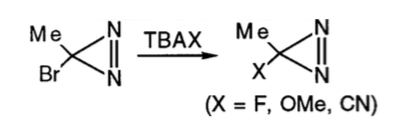Chemistry:Graham reaction
From HandWiki
In organic chemistry, the Graham reaction is an oxidation reaction that converts an amidine into a diazirine using a hypohalite reagent. The halide of the hypohalite oxidant, or another similar anionic additive to the reaction, is retained as a substituent on the diazirine product. The reaction was first reported in 1965.[1] Various reaction mechanisms have been proposed.[2][3]
Amidine substrates for the reaction can easily be formed from the corresponding nitriles via the Pinner reaction. The halide substituent in the diazirine product can be displaced by a various nucleophiles.[4]
References
- ↑ Graham, W. H. (1965-10-01). "The Halogenation of Amidines. I. Synthesis of 3-Halo- and Other Negatively Substituted Diazirines". Journal of the American Chemical Society 87 (19): 4396–4397. doi:10.1021/ja00947a040. ISSN 0002-7863.
- ↑ Rzepa, Henry (February 18, 2019). "The Graham reaction: Deciding upon a reasonable mechanism and curly arrow representation". https://www.ch.imperial.ac.uk/rzepa/blog/?p=20464.
- ↑ Moss, Robert A.; Wlostowska, Joanna; Guo, Wenjeng; Fedorynski, Michal; Springer, James P.; Hirshfield, Jordan M. (1981). "Mechanism of Graham's reaction". J. Org. Chem. 46 (24): 5048–5050. doi:10.1021/jo00337a061.
- ↑ Moss, Robert A. (2006-02-09). "Diazirines: Carbene Precursors Par Excellence". Accounts of Chemical Research 39 (4): 267–272. doi:10.1021/ar050155h. ISSN 0001-4842. PMID 16618094.
 |



